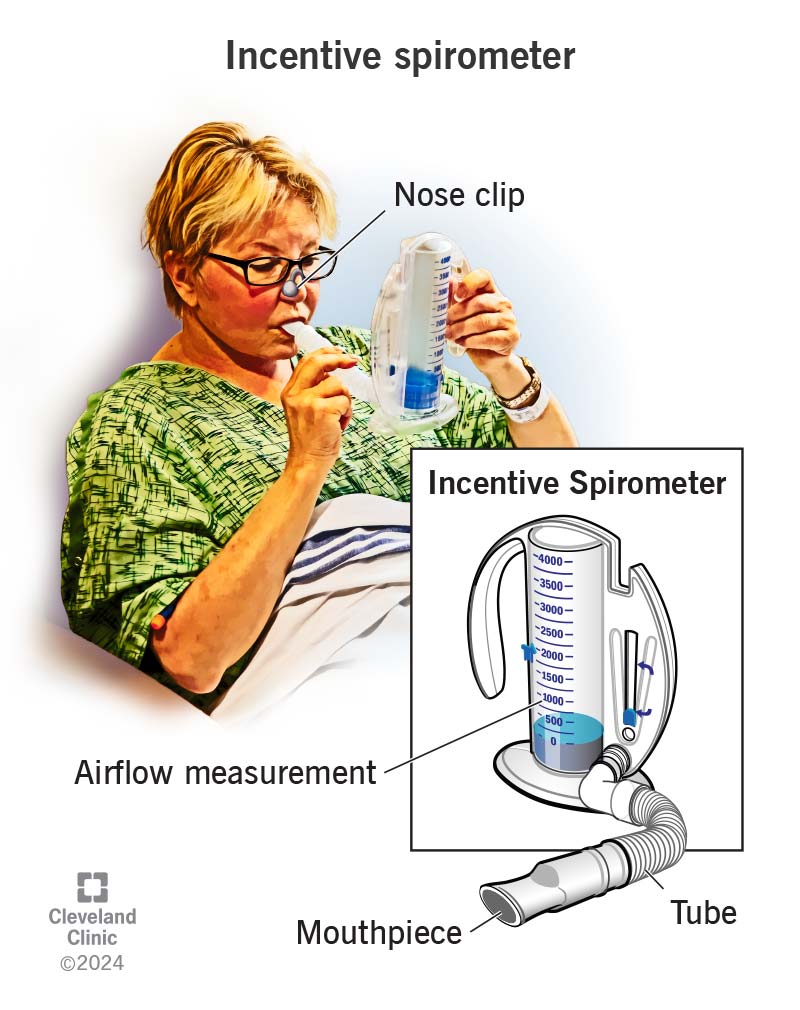An incentive spirometer is a medical device that helps your lungs. Your healthcare provider will help you establish goals. The more you use your incentive spirometer, the stronger your lungs get. Your healthcare provider will also teach you how to use the device properly.

An incentive spirometer (spy-rom-uh-ter) is a simple, plastic medical device that exercises your lungs. Your healthcare provider may recommend that you use an incentive spirometer after an illness, surgery or an injury to your chest or abdomen.
An incentive spirometer helps prevent lung infections by expanding your lungs, strengthening your lungs, keeping your lungs inflated and clearing mucus and other secretions from your chest and lungs. You may have low oxygen levels after surgery or a serious illness, and an incentive spirometer helps you achieve a normal oxygen level.
An incentive spirometer is small. It’s about the size of a small bottle, and you can hold it in one hand.
Cleveland Clinic is a non-profit academic medical center. Advertising on our site helps support our mission. We do not endorse non-Cleveland Clinic products or services. Policy
With regular use, an incentive spirometer helps your lungs expand so you can take deep, full breaths instead of short, shallow breaths.
An incentive spirometer is like an exercise machine for your lungs. It helps you maintain your lung strength, or it helps your lungs get stronger after an injury or illness.
After surgery, an incentive spirometer can:
There are two types of incentive spirometer:
Your healthcare provider may give you an incentive spirometer in the following situations:
To properly use an incentive spirometer, you should:
If you feel dizzy or lightheaded at any point while using an incentive spirometer, immediately stop using the device and alert your healthcare provider.
When you’re awake, you should use your incentive spirometer at least 10 times every hour.
Yes, there are some risks associated with using an incentive spirometer.
If you don’t properly clean and disinfect your incentive spirometer, it’s possible for you to spread bacteria. Clean your incentive spirometer’s tubing, breathing valve and mouthpiece before someone else uses it.
An incentive spirometer also requires you to exhale deeply, which may spread airborne microbes such as influenza and COVID-19. It’s a good idea to avoid using an incentive spirometer around other people, especially if you’re not feeling well.
If you have cystic fibrosis, you’re also at a higher risk of upper respiratory tract infections when you use an incentive spirometer or other lung function testing equipment.
If you have an incentive spirometer for home use, it’s a good idea to clean it daily.
Detach the mouthpiece from the base of the device and clean it with clean running water and antibacterial soap for about 20 seconds. Then wash the rest of the spirometer with water and soap.
You can also put on protective gloves and soak the separate pieces in a 5% bleach and water solution for about five to 10 minutes. Periodically swish the pieces in the solution to help clean the device. Thoroughly rinse the pieces in clean running water after five to 10 minutes.
Make sure the incentive spirometer is dry before your next use.
An incentive spirometer isn’t specifically good for your heart. However, it’s helpful as you recover from many types of surgery, including open heart surgery.
During many open heart surgery procedures, your healthcare provider will hook you up to a heart-lung bypass machine. A heart-lung bypass machine connects to your heart. It temporarily takes over for your heart and lungs, so blood still circulates around your body, but it moves away from your heart. It also deflates your lungs.
When there is no air in your lungs, they may create mucus. An incentive spirometer helps remove the mucus and other fluids from your lungs as you recover from the procedure.
A note from Cleveland Clinic
An incentive spirometer is a medical device that helps your lungs recover after surgery or a lung illness. You may find it challenging to use the device at first, but keep it up! The more you use an incentive spirometer, the stronger your lungs will get. Don’t forget to use the indicator on the side of the device to help you track your progress and achieve your goals.
Your healthcare provider can answer any questions you have about how to use the device.
Last reviewed by a Cleveland Clinic medical professional on 08/31/2022.
Learn more about our editorial process.
Cleveland Clinic is a non-profit academic medical center. Advertising on our site helps support our mission. We do not endorse non-Cleveland Clinic products or services. Policy